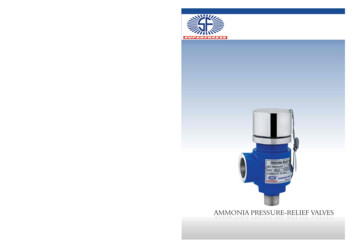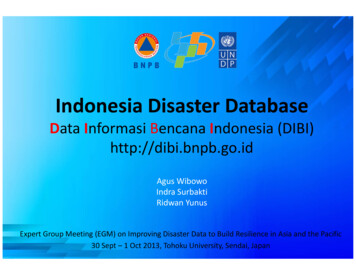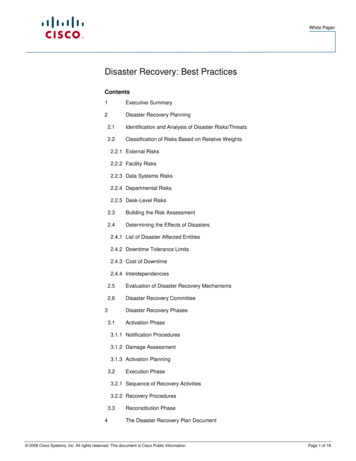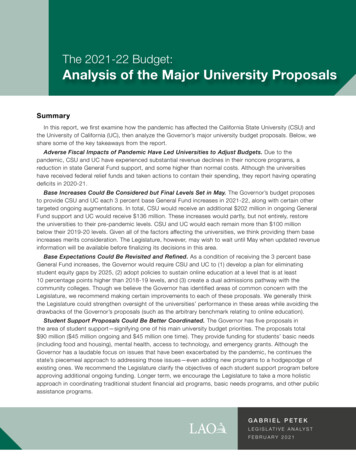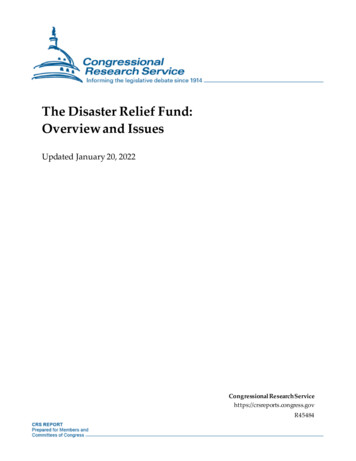
Transcription
The Disaster Relief Fund:Overview and IssuesUpdated January 20, 2022Congressional Research Servicehttps://crsreports.congress.govR45484
SUMMARYThe Disaster Relief Fund: Overview and IssuesThe Disaster Relief Fund (DRF) is one of the most-tracked single accounts funded by Congresseach year. Managed by the Federal Emergency Management Agency (FEMA), it is the primarysource of funding for the federal government’s domestic general disaster relief programs. Theseprograms, authorized under the Robert T. Stafford Disaster Relief and Emergency AssistanceAct, as amended (42 U.S.C. 5121 et seq.), outline the federal role in supporting state, local, tribal,and territorial governments as they respond to and recover from a variety of incidents. They takeeffect in the event that nonfederal levels of government find their own capacity to deal with anincident is overwhelmed.R45484January 20, 2022William L. PainterSpecialist in HomelandSecurity andAppropriationsThe appropriation which feeds the DRF predates current disaster relief programs and FEMA itself. It dates back to a halfmillion dollar deficiency appropriation to the President in 1948 that allowed him to use these resources to provide temporaryemergency assistance to communities in the wake of unspecified potential natural disasters. Although the appropriation wasprovided with one particular Upper Midwest flooding incident in mind, the legislative language allowed the funding to beused more broadly if the President wished to do so. This policy of providing general disaster relief was a shift from previouspolicy, which largely left emergency management, disaster relief, and disaster recovery to other levels of government andprivate relief organizations. Prior to the development of the general relief program, when the federal government involveditself in disaster response and recovery, it was on an ad hoc, case-by-case basis. In the early 21st century, emergencymanagement has its own federal agency.The evolving federal role in disaster relief is partially illuminated by the robust funding stream provided for it through theDRF. At the end of FY2021, the DRF carried over a balance of almost 36 billion, after obligating more than 55 billion in asingle fiscal year. However, what is a fixture of federal policy today was not a given a century ago. Examining the history ofthe DRF and the programs it supports may help Congress consider future approaches to disaster relief.This report introduces the DRF and provides a brief history of federal disaster relief programs. It goes on to discuss theappropriations that fund the DRF, and provides a funding history from FY1964 to the present day, discussing factors thatcontributed to those changing appropriations levels. It concludes with discussion of how the budget request for the DRF hasbeen developed and structured, given the unpredictability of the annual budgetary impact of disasters, and raises somepotential issues for congressional consideration.This report is updated on an annual basis.Congressional Research Service
The Disaster Relief Fund: Overview and IssuesContentsIntroduction . 1What is the Disaster Relief Fund and how is it used?. 1What determines whether an incident qualifies as an emergency or disaster? . 1Does all federally funded disaster relief come from the DRF?. 2What federal government activities are funded under the DRF? . 2Under what statute is the Disaster Relief Fund authorized? . 4Where are appropriations for the Disaster Relief Fund provided? . 4Are specific Disaster Relief Fund appropriations for specific disasters? . 4How is the DRF being spent today?. 5How is the DRF being used to respond to COVID-19?. 5Historical Context for Federal Disaster Relief Funding . 81789-1947: Case by Case, After the Fact . 81947-1950: General Disaster Relief Funding from the Federal Government Begins . 101950-1966: The Disaster Relief Act of 1950—General Relief and Specific Relief . 111966-1974: The Disaster Relief Act of 1966—General Relief Broadens . 121974-Present: The Era of Federally Coordinated Emergency Management . 13Pandemic COVID-19 and the Stafford Act . 14Appropriations for General Disaster Relief. 16Types of Appropriations for Disaster Relief . 16Supplemental Appropriations for Disaster Relief . 16Annual Appropriations . 17Continuing Appropriations. 18DRF Funding History: FY1964-FY2021 . 19Factors in Changing Appropriations Levels . 23Incident Frequency and Severity. 23Programmatic Changes in Disaster Relief. 27Changes in the Budget Process . 28Budgeting Practices for Disaster Relief. 30Management of Disaster Relief Funds. 301978: The Creation of the Federal Emergency Management Agency . 31Calculation of the Annual Appropriations Request . 31Emergency Contingency Funding and Reserve Funds . 35Rescissions and the DRF . 36Issues for Congress . 37Should the purpose of the DRF be rescoped? . 37How much is enough to have on hand? . 38What accommodations should be made in the federal budget for disaster relief? . 39FiguresFigure 1. COVID-19 DRF Obligations by Program and Fiscal Quarter . 7Figure 2. Nominal Dollar Disaster Relief Appropriations, FY1964-FY2021 . 21Figure 3. FY2021 Dollar Disaster Relief Appropriations, FY1964-FY2021 . 22Figure 4. Catastrophic Disaster Costs, DRF Appropriations and Obligations . 27Congressional Research Service
The Disaster Relief Fund: Overview and IssuesFigure 5. DRF Annual and Supplemental Appropriations Within and BeyondDiscretionary Spending Limits, FY2004-FY2021. 30TablesTable 1. Disaster Declaration Activities and Projected Costs of Catastrophic DisasterDeclarations, FY2004-FY2020. 24Table A-1. Nominal Dollar Disaster Relief Appropriations, FY1964-FY2021 . 40Table A-2. FY2021 Dollar Disaster Relief Appropriations, FY1964-FY2021. 42AppendixesAppendix. General Disaster Relief Appropriations, FY1964-FY2021 . 40ContactsAuthor Information . 44Congressional Research Service
The Disaster Relief Fund: Overview and IssuesIntroductionThe Disaster Relief Fund (DRF) is one of the most-tracked single accounts funded by Congresseach year. Managed by the Federal Emergency Management Agency (FEMA), it is the primarysource of funding for the federal government’s domestic general disaster relief programs. Theseprograms, authorized under the Robert T. Stafford Disaster Relief and Emergency Ass istance Act,as amended (42 U.S.C. 5121 et seq.), outline the federal role in supporting state, local, tribal, andterritorial governments as they respond to and recover from a variety of incidents. They takeeffect in the event that nonfederal levels of government find their capacities to deal with anincident overwhelmed.Although the concept of general disaster relief provided by the federal government predates bothFEMA and the Stafford Act, federal involvement in relief after natural and man-made disasterswas very rare before the Civil War and was at times considered unconstitutional. Domesticdisaster relief efforts became more common after the Civil War, but were not seen as a necessaryobligation of the federal government. Standing federal domestic disaster relief programs and apool of resources to fund them only emerged after the Second World War. Prior to thedevelopment of these programs, domestic disaster relief and recovery was a matter for privatenongovernmental organizations and state and local governments.Once established, the federal role in domestic disaster response and recovery grew, provingpolitically popular and resilient despite periodic concerns about management, execution, andbudgetary impacts. The DRF is the source of funding for most general disaster relief programs, soit is an indicator of the scope of those programs and the volume of taxpayer-funded aid theyprovide. Understanding the trends in the growth of the federal government’s role in generaldisaster relief and recovery, and the associated costs of that role, may be useful as Congressconsiders changes in both emergency management and budgetary polic ies.This report introduces the DRF and provides a brief history of federal disaster relief programs. Itgoes on to discuss the appropriations that fund the DRF, and provides a funding history fromFY1964 to the present day, discussing factors that contributed to those changing appropriationslevels. It concludes with discussion of how the budget request for the DRF has been developedand structured, given the unpredictability of the annual budgetary impact of disasters, and raisessome potential issues for congressional consideration.What is the Disaster Relief Fund and how is it used?The DRF is the primary source of funding for the federal government’s general disaster reliefprogram—response and recovery activities pursuant to a range of domestic emergencies anddisasters defined in law—as opposed to specific relief and recovery initiatives that may beenacted for individual incidents. 1What determines w hether an incident qualifies as an emergency or disaster?Under the Robert T. Stafford Disaster Relief and Emergency Assistance Act (P.L. 93-288, asamended; hereinafter “the Stafford Act”), the President can declare that an emergency exists or a1Occasional transfers from the DRF have been used to pay for specific Stafford Act programs (the Disaster AssistanceDirect Loan Program) or Inspector General oversight activities, and CRS has identified two instances whereappropriations provided to the DRF were made for specific incidents (the 9/11 attack on New York City) or programs(Other Needs Assistance for COVID-19 pandemic-related funeral expenses).Congressional Research Service1
The Disaster Relief Fund: Overview and Issuesmajor disaster is occurring. 2 These declarations make state, tribal, territorial, and localgovernments 3 eligible for a variety of assistance programs, many of which are funded from theDRF. 4 Declarations usually are made at the request of a state, tribal, or territorial government.Does all federally funded disaster relief come from the DRF?While the DRF funds Stafford Act disaster relief and recovery programs, several other federaldepartments and agencies have significant roles in disaster preparedness, relief, recovery, andmitigation. These include the Department of Housing and Urban Development, the SmallBusiness Administration, U.S. Department of Agriculture, U.S. Army Corps of Engineers, and theDepartment of Health and Human Services. While FEMA may fund some of their activities out ofthe DRF through mission assignments, 5 their broader disaster-related programs are fundedthrough separate appropriations. 6What federal government activities are funded under the DRF?Currently, the Federal Emergency Management Agency (FEMA) coordinates federal disasterresponse and recovery efforts. As such, it manages the DRF, which funds activities in fivecategories:1. Activity pursuant to a major disaster declaration—This activity represents thevast majority of spending from the DRF. FEMA’s primary “Direct DisasterPrograms” are the Individual Assistance (IA), 7 Public Assistance (PA), 8 and theHazard Mitigation Grant Program (HMGP) programs. 9 Federal assistanceprovided by other federal agencies at FEMA’s direction through “missionassignments” is also paid for from the DRF. 102Or has occurred—declarations are specific by time and place.3As well as certain private nonprofit organizations as stipulated in the Stafford Act.For more information, see CRS Report R43784, FEMA’s Disaster Declaration Process: A Primer, by Bruce R.Lindsay.45Mission assignments are directives from FEMA to other federal agencies to perform specific work in response to aStafford Act emergency or disaster declaration. T he federal agency can seek reimbursement from FEMA for the costsincurred. For information on how FEMA manages these activities, see nments.6 For information on the breadth of federal disaster relief, see CRS Report R41981, Congressional Primer onResponding to and Recovering from Major Disasters and Emergencies, by Bruce R. Lindsay and Elizabeth M.Webster; and U.S. Government Accountability Office, Federal Disaster Assistance: Federal Departments and AgenciesObligated at Least 277.6 Billion during Fiscal Years 2005 through 2014, GAO-16-797, September 22, 2016,https://www.gao.gov/products/GAO-16-797.7For more information, see CRS Report R46014, FEMA Individual Assistance Programs: An Overview, by ElizabethM. Webster8 For more information, see CRS Report R46749, FEMA’s Public Assistance Program: A Primer and Considerationsfor Congress, by Erica A. Lee9For more information, see CRS Insight IN11187, Federal Emergency Management Agency (FEMA) HazardMitigation Assistance, by Diane P. Horn10Department of Homeland Security, Disaster Relief Fund, Fiscal Year 2019 Congressional Budget Justification ,Federal Emergency Management Agency, Washington, DC, February 2018, p. FEMA-DRF-23, ongressional Research Service2
The Disaster Relief Fund: Overview and Issues2. Predeclaration surge activities—These are activities undertaken prior to anemergency or major disaster declaration to prepare for response and recovery,such as deploying response teams or prepositioning equipment.3. Activity pursuant to an emergency declaration—This is federal assistance tosupplement state and local efforts in providing emergency services in any part ofthe United States.4. Fire Management Assistance Grants (FMAGs) for large wildfires—This isassistance for the mitigation, management, and control of any fires on public orprivate lands that could, if unchecked, worsen and result in a major disasterdeclaration. 115. Disaster Readiness and Support (DRS) activities—These are ongoing, nonincident-specific activities that allow FEMA to provide timely disaster response,operate its programs responsively and effectively, and provide oversight of itsemergency and disaster programs.The role of the federal government has evolved over the years, as described in the sections below,but emergency response and disaster relief has historically been a federalized “bottom-up”operation, starting from the local or tribal governments affected, backed up by the state orterritorial government, 12 and then turning to the federal government if their capacity isoverwhelmed. The broadening of the federal role has been a factor in which activities are fundedunder the DRF.DRF Activities and Statutory Budget ControlsImplementation of budget controls in 2011 led to changes in the way DRF appropriations were structured tosupport Stafford Act activities. Since FY2012, the first fiscal year of statutory limits on discretionary spendingunder the Budget Control Act (BCA), a distinction has been made between budget authority for the activitiespursuant to a specific major disaster declaration—the first of the activities listed above—and budget authority forother activities. The former now often carries a special “disaster relief” designation, defining it as being providedpursuant to a major disaster declaration under the Stafford Act, and includes language triggering an adjustment indiscretionary spending limits to accommodate it. Budget authority for the other four activities, covering otherStafford Act functions not linked to response and recovery from a specific major disaster, is derived from theundesignated portion, referred to as the “base.” This remaining budget authority is counted against discretionaryspending limits.There is no direct limit in the plain language of the appropriation that would restrict “base” funds from being usedfor major disasters. However, under concepts of appropriations law intended to prevent the executive branchfrom improperly augmenting funding for specific activities beyond Congress’s intention, the designation of part ofthe DRF as for the costs of major disasters can be interpreted as a limitation that prevents the rest of the DRFfrom being used for that purpose. During the response to Hurricane Harvey in 2017, funds were reprogrammedfrom the base to cover the costs of major disaster response, then replenished afterwards.Although the statutory discretionary budget limits laid out in the BCA and the disaster relief adjustmentmechanisms expired after FY2021, a similar adjustment was included in the FY2022 budget resolution to provideflexibility within the congressional budget process, and the proposed structure of the FY2022 DRF appropriationmaintained the structure of the BCA years.11For more information, see CRS Report R43738, Fire Management Assistance Grants: Frequently Asked Questions,by Bruce R. Lindsay and Katie Hoover.12 T ribal governments currently may seek help directly from FEMA if their capacity to respond to an incident isoverwhelmed, as a result of changes to the Stafford Act made by Section 1110 of the Sandy Reco very ImprovementAct of 2013 (P.L. 113-2, Division B).Congressional Research Service3
The Disaster Relief Fund: Overview and IssuesUnder what statute is the Disaster Relief Fund authorized?The DRF is not separately authorized as a distinct entity, but the activities it funds are authorizedunder the Stafford Act (42 U.S.C. 5121 et seq.).Where are appropriations for the Disaster Relief Fund provided?Since FY1980—FEMA’s first annual appropriation—the DRF has been funded through its ownappropriation within FEMA’s budget, first under the heading “Disaster Relief,” and then“Disaster Relief Fund” starting in FY2012. FEMA’s annual appropriations were first providedthrough the VA, HUD, and Independent Agencies Appropriations Act, but have been included inthe Department of Homeland Security Appropriations act since FY2004. Since the first “DisasterRelief” appropriation for FY1948, most of the DRF’s appropriations have been provided throughsupplemental appropriations. See Figure 2 and Figure 3 for details.Are specific Disaster Relief Fund appropriations for specific disasters?DRF appropriations have historically been provided for general disaster relief, rather than specificpresidentially declared disasters or emergencies.The most recent iterations of the appropriations bill text indicate the funds are provided for the“necessary expenses in carrying out the Robert T. Stafford Disaster Relief and EmergencyAssistance Act,” thus covering all past and future disaster and emergency declarations. 13 Previousversions of the appropriations language going back to 1950 also referenced the legislationauthorizing general disaster relief rather than targeting specific disasters. On a number ofoccasions, specific disasters have been mentioned in the appropriation, but funding was notspecifically directed to one disaster over others.While many disaster supplemental appropriations bills are associated with a specific incident orincidents—such as P.L. 113-2, “the Sandy Supplemental”—the language in that act does not limitthe use of the disaster relief appropriation to that specific incident. 14CRS has identified two exceptions to this practice: P.L. 107-117 and P.L. 107-206 provided a total of 8.04 billion in resources to theDisaster Relief Fund, specifically for expenses “to respond to the September 11,2001, terrorist attacks on the United States.”15P.L. 116-260, Division M (the Coronavirus Response and Relief SupplementalAppropriations Act, 2021), included a 2 billion supplemental appropriation forthe DRF and specifically provided for COVID-19 disaster-related funeralexpenses.13P.L. 115-141, Div. F.14See, for this specific example, 127 Stat. 28.15 4,356,871,000 in P.L. 107-117 (115 Stat. 2338) from a prior appropriation, as well as 1,030,000,000 transferredfrom the T SA (116 Stat. 879) and 2,650,700,000 in a supplemental appropriation (116 Stat. 894) in P.L. 107-206.Congressional Research Service4
The Disaster Relief Fund: Overview and IssuesHow is the DRF being spent today?Since the enactment of P.L. 112-74, Congress has received regular reporting on spending from theDRF. Monthly reports on such spending since March 2013 are available on FEMA’s website. 16Currently, the reports include information on DRF balances, actual and projected obligations fromthe DRF for large-scale disasters broken down by disaster declaration, and obligations andexpenditures aggregated by incident. These reports also include estimates of the DRF balancethrough the end of the current fiscal year.CRS analysis of FEMA-reported data indicates that from FY2010 to FY201917 55% of DRF obligations were for Public Assistance programs under the StaffordAct;15% was for Individual Assistance, including disaster housing; 7% went to Mitigation; 7% went to Operations; and16% went to Administration.How is the DRF being used to respond to COVID-19?Major disaster declarations under the Stafford Act for the COVID-19 pandemic were the firstissued for an infectious disease incident, and led to the first uses of the Stafford Act’s majordisaster authorities to use DRF resources in response to and recovery from such an incident. 18On March 13, 2020, President Donald J. Trump made a series of emergency declarations underSection 501(b) of the Stafford Act in response to the nationwide spread of a novel coronavirusdisease (COVID-19). 19 The declarations authorized assistance to all U.S. states, territories, tribes,and the District of Columbia. At the time he announced the declarations, he invited the recipientsof those declarations to request major disaster declarations. 20 Fifty states, five territories, theDistrict of Columbia, and three federally-recognized tribes have all requested and received majordisaster declarations for COVID-19 response. 2116T hese monthly reports are available at er-relief-fund-monthlyreports.17Due to the novel demands placed on the DRF by the COVID-19 pandemic response in FY2020, includinghistorically large obligations in atypical distributions, data from FY2020 going forward are not included in thisanalysis.18Prior to the COVID-19 pandemic, four emergency declarations were made under the Stafford Act for public healthincidents. For information on these incidents, see CRS Insight IN11229, Stafford Act Assistance for Public HealthIncidents. T he difference in scale between these incidents and the COVID-19 declaration is several orders ofmagnitude: for example, under one of these emergency declarations, New Jersey received a little over 2 million forWest Nile from the DRF in 2000 (according to the Emergency Management Section of the New Jersey State Police),and 2,931 million under the COVID-19 disaster declaration from the DRF as of the end of FY2021 (according toFEMA’s October 2021 monthly report on the DRF).19 While the president made a single announcement, the declarations themselves apply to each individual state,territory, or asters/coronavirus/disaster-declarations, as retrieved January 18, 2022. FEMA also notesthat 32 tribes are working with FEMA under the emergency declarations.Congressional Research Service5
The Disaster Relief Fund: Overview and IssuesThe Joseph R. Biden Administration has taken a different approach in exercising FEMA’sauthorities. Under the Biden Administration, FEMA has provided extensive direct federalassistance to states, particularly in assisting with vaccine administration, and authorized thePublic Assistance program to reimburse the costs of safe operations and reopening of eligiblefacilities 22 —unlike the Trump Administration, which more narrowly applied Public Assistance tocosts directly associated with COVID-19 pandemic response. President Biden also increased thefederal share of costs covered to 100%.23Figure 1 shows the breakdown of COVID-19 spending by Stafford Act program by fiscalquarter—the first major disaster declarations were made in the final weeks of the second quarterof FY2020, so the amount shown in the figure represents less than a month’s obligations. Thefourth quarter of FY2020 included the six weeks of spending for the Trump Administration’s LostWages Assistance initiative, funded through the Individual Assistance program. The secondquarter of FY2021 starts with January 2021, which includes the transition to the BidenAdministration, so that quarter and those thereafter reflect the Biden Administration’s approach tousing DRF resources to fund Stafford Act COVID-19 pandemic response and recovery.Executive Office of the President, “ Memorandum to Extend Federal Support to Governors’ Use of the NationalGuard to Respond to COVID- 1 9 and to Increase Reimbursement and Other Assistance Provided to States,” January 21,2021, 86 Federal Register 7481-7482.23Federal Emergency Management Agency, “Coronavirus (COVID-19) Pandemic: Safe Opening and Operation WorkEligible for Public Assistance (Interim),” FEMA Policy 104-21-0003, Version 2, September 8, 2021, p. 1. Available ts/fema iblepublic-assistance-interim-policy 2 09082021.pdf.22Congressional Research Service6
The Disaster Relief Fund: Overview and IssuesFigure 1. COVID-19 DRF Obligations by Program and Fiscal QuarterSource: CRS analysis of data compiled from FEMA DRF monthly reports, Appendix C.Notes: Amounts shown do not reflect recovery of funding made under that category after the end of the fiscalyear in which funds were initially obligated. Both FY2020 Quarter 3 and FY2021 Quarter 2 show net negativeamounts for Administrative costs and Individual Assistance, respectively, due to recovery of funding obligatedunder that category within the fiscal year.As of the end of the first quarter of FY2022, FEMA associated 89.296 billion in DRF spendingwith the COVID-19 response. 24 Of this amount, 40.969 billion was provided through theIndividual Assistance program, the vast majority of which was for the lost wages initiative; 39.366 billion was provided for Public Assistance programs, which reimburses eligible publicand nonprofit entities for the costs of major disaster response and recovery; and another 8.067billion supported operational costs, including mission assignments. 2524Ibid., p. 13.Federal Emergency Management Agency, January 2022 Disaster Relief Fund Report, p. nts/fema sional Research Service7
The Disaster Relief Fund: Overview and IssuesHistorical Context for Federal Disaster ReliefFundingDisaster relief has not always been a part of the mission of the federal government. For nearly 80years, federal domestic disaster relief was minimal, extremely narrow in scope, and largely didnot address humanitarian needs, leaving those to private organizations and local levels ofgovernment. Even as the country emerged from the Civil War with more of a national identity anda sense that the federal government could act to provide relief in some circumstances, disaster aidremained limited, responding only after the fact on a case-by-case basis. Only after World War IIdid the concept emerge of a federal role in responding to disasters. This new role was morebroadly defined, led by the President and funded in advance, as opposed to case-by-caseresponses to needs in the wake of the most severe events led by ad hoc congressional action. Overthe ensuing years, the
Nov 13, 2020 · The Disaster Relief Fund: Overview and Issues Congressional Research Service 2 governments2 eligible for a variety of assistance programs, many of which are funded from the DRF.3 Declarations usually are made at the request of a state, tribal, or territorial government. Does all federally f

